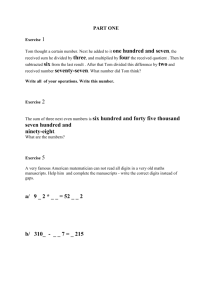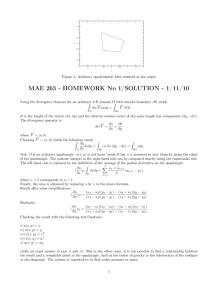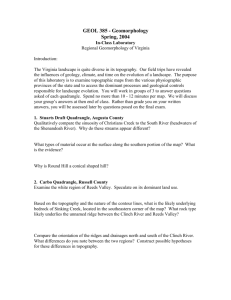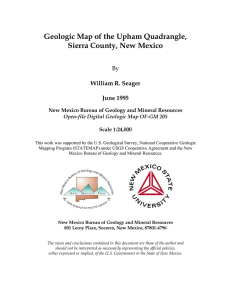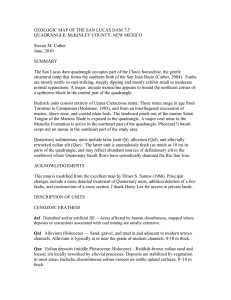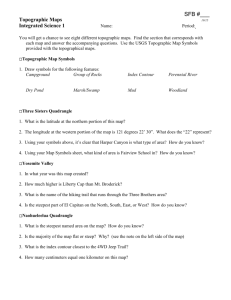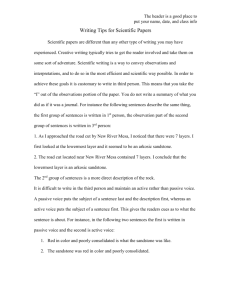Geologic Map of the Table Mountain Quadrangle, Socorro County, New Mexico. By
advertisement
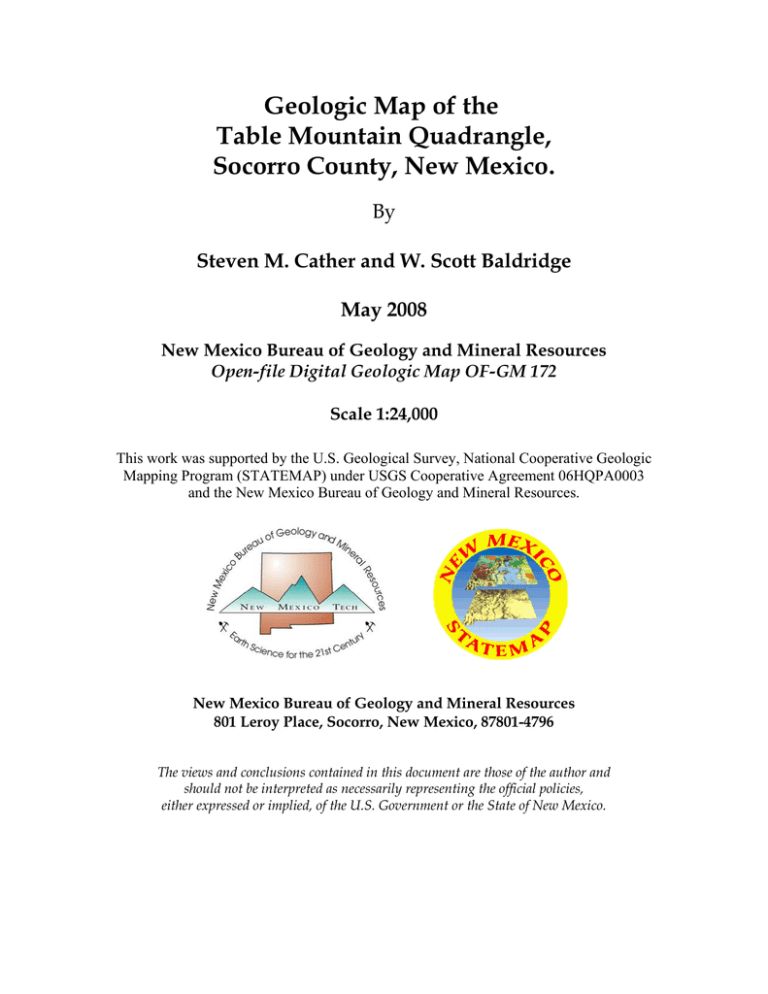
Geologic Map of the Table Mountain Quadrangle, Socorro County, New Mexico. By Steven M. Cather and W. Scott Baldridge May 2008 New Mexico Bureau of Geology and Mineral Resources Open-file Digital Geologic Map OF-GM 172 Scale 1:24,000 This work was supported by the U.S. Geological Survey, National Cooperative Geologic Mapping Program (STATEMAP) under USGS Cooperative Agreement 06HQPA0003 and the New Mexico Bureau of Geology and Mineral Resources. New Mexico Bureau of Geology and Mineral Resources 801 Leroy Place, Socorro, New Mexico, 87801-4796 The views and conclusions contained in this document are those of the author and should not be interpreted as necessarily representing the official policies, either expressed or implied, of the U.S. Government or the State of New Mexico. GEOLOGIC MAP OF THE TABLE MOUNTAIN 7.5-MINUTE QUADRANGLE, SOCORRO COUNTY, NEW MEXICO Steven M. Cather1 and W. Scott Baldridge2 1 New Mexico Bureau of Geology and Mineral Resources, Socorro, NM 87801 2 Los Alamos National Laboratory, Los Alamos, NM 87545 May, 2008 The Table Mountain Quadrangle lies on the southeast margin of the Colorado Plateau, about 30 km northwest of Magdalena, New Mexico. Rocks exposed on the quadrangle range in age from Late Triassic to Pliocene, and unconsolidated deposits of Quaternary age are widespread. The quadrangle is transected by the Rio Salado, a major east-flowing tributary to the Rio Grande. Upper Triassic red beds (mostly mudstone) of the Chinle Group are poorly exposed in the northeast part of the quadrangle. These are unconformably overlain by a thick succession of Upper Cretaceous marine and non-marine strata, including the Dakota Sandstone (main body and Twowells tongue), Mancos Shale (lower part, Rio Salado Tongue, and D-Cross Tongue), Tres Hermanos Formation, and Mesaverde Group (Gallup Sandstone and Crevasse Canyon Formation). The Crevasse Canyon Formation is coalbearing (Osburn, 1982). Upper Cretaceous strata are disconformably overlain by red beds of the middle Eocene Baca Formation. The Baca Formation was deposited during the late part of the Laramide orogeny by fluvial and lacustrine processes (Cather, 1980). The Baca Formation is transitionally overlain by volcaniclastic deposits of the middle EoceneOligocene Datil Group (Brouillard, 1984; Cather, 1986). The Datil Group and overlying ignimbrites hold up the high terrane of the Gallinas Mountains south of the study area. Following a period of major erosion in the late Oligocene-early Miocene, piedmont sand and gravel (Tpg; Miocene?-Pliocene) began to accumulate in the western and southern part of the quadrangle. In the southern part of the quadrangle, Tpg appears to have been derived from the Gallinas Mountains. There, the predominant clast type is volcaniclastic rocks of the lower Datil Group. In the northern part of the quadrangle, Tpg consists predominantly (>95%) of volcanic clasts; most are ignimbrite clasts. Clasts of yellow Upper Cretaceous sandstone compose the non-volcanic gravel fraction. Pebble imbrication in Tpg on the west side of Tres Hermanos Mesa near the north edge of the quadrangle shows easterly paleoflow (Fig. 1). These data indicate Tpg in areas north of the Rio Salado was derived from the west, not the south as interpreted by Osburn (1984). An extensive Oligocene ignimbrite section, now eroded, in the area west of the Red Lake fault zone was the probable source of these clasts. Tpg in the north part of the quadrangle may represent deposits of the ancestral Rio Salado prior to deep incision. Basaltic lava and tephra were erupted from several vents in the Table Mountain-Tres Hermanos Mesa area during the Pliocene (Baldridge et al., 1987). These lavas are intercalated with the upper part of Tpg. On the west side of Tres Hermanos Mesa, basalt flows TbH2 through TbH5 overlie a concave-up surface on Tpg which may represent a valley-fill of the ancestral Rio Salado. Quaternary deposits comprise valley-fill and terrace deposits, talus and colluvium, stream sands, and alluvial and eolian veneers on upland surfaces. The Table Mountain quadrangle is structurally simple. Pre-Pliocene strata are generally tilted gently (~5-10 degrees) to the south-southwest. Several open, gently south- to southwest-plunging folds are present in the eastern part of the quadrangle. Steeply dipping, northeast- to northwest-striking normal faults are present near Table Mountain and Tres Hermanos Mesa. The proximity of the faults with basaltic eruptive centers implies that magma ascent may have been structurally controlled at depth. Faults that cut basalt flows on Table Mountain are younger than 3.7 ± 0.1 Ma. Folds on the quadrangle may be as old as Laramide. References Cited Baldridge, W. S., Perry, F.V.; Shafiqullah, M., 1987, Late Cenozoic volcanism of the southeastern Colorado Plateau; I, Volcanic geology of the Lucero area, New Mexico : Geological Society of America Bulletin, v. 99, p. 463-470. Broulliard, L.A., 1984, Geology of the northeastern Gallinas Mountains, Socorro County, New Mexico [M. S. thesis], Socorro, New Mexico Institute of Mining and Technology, 161 p. Cather, S.M., 1980, Petrology, diagenesis, and genetic stratigraphy of the Eocene Baca Formation, Alamo Navajo Reservation and vicinity, Socorro County, New Mexico [M.A. thesis], Austin, The University of Texas at Austin, 240 p. Cather, S.M., 1986, Volcano-sedimentary evolution and tectonic implications of the Datil Group (latest Eocene–early Oligocene), west-central New Mexico [Ph. D. thesis], Austin, The University of Texas at Austin, 484 p. Osburn, J.C., 1982, Geology and coal resources of the Alamo Band Navajo Reservation, Socorro County, New Mexico: New Mexico Bureau of Mines and Mineral Resources, Open-file Report 160, 160 p. Osburn, J.C., 1984, Geology of the Pueblo Viejo Mesa quadrangle, Socorro and Cibola Counties, New Mexico: New Mexico Bureau of Mines and Mineral Resources, Geologic Map GM-55, scale 1:24,000. DESCRIPTION OF UNITS Alluvial deposits (Pleistocene-Recent) Qsg - Sand, gravel, and silt in modern ephemeral stream channels, 0-15 m thick Qtc - Talus and colluvium, 0-10 m thick Qae - Sand, silt, and gravel deposited on upland surfaces by fluvial and eolian processes Qvy - valley-fill sands, silts, and gravels near modern stream grade, 0-15 m thick Qvo - older valley-fill sands, silts, and gravels >2-3 m above modern stream grade, 0-10 m thick Qt - Stream terrace sands, silts, and gravels related to the ancestral Rio Salado; 0-7 m thick Tb - Basaltic lava flows (Pliocene); subscripts correspond to flow units, in ascending stratigraphic order, of Baldridge et al. (1987), except TM = Table Mountain; K-Ar dates from Baldridge et al. (1987); sample numbers correspond to analyses in Table 1 TbTM - Alkali olivine basalt, light gray in color; phenocrysts of olivine; rare megacrysts of plagioclase, flow approximately 8 m thick; sample number 385; 3.7 + 0.1 Ma TbH6 - Basanite, probably a composite unit consisting of coalesced flows from several vents, phenocrysts of olivine; megacrysts of plagioclase and black augite; vesicular, platy parting, light gray in color with spotted appearance on weathered surfaces along eastern Tres Hermanos Mesa, xenoliths of pyroxenite and granulite are abundant; thickness ranges from 8 m along western edge of Tres Hermanos Mesa to 20 m along eastern edge, where it is separated from underlying flow (TbH5) by 2-4 m of basaltic ash and cinders and, locally, piedmont gravel (Tpg); along western Tres Hermanos Mesa this unit is separated from underlying unit (TbH5) by up to 24 m of piedmont gravels (Tpg); sample numbers 356 and 375 TbH5 - Basanite; possibly a composite unit consisting of coalesced flows from several vents, dark gray in color, with phenocrysts of olivine and plagioclase; ranges from dense to vesicular with platy parting; xenoliths of granulite and megacrysts of plagioclase and black augite are present along western edge of Tres Hermanos Mesa; flow is 6-7 m thick and overlies 2-3 m of scoriaceous rubble on southern end of Tres Hermanos Mesa; this unit overlies a thin (< 0.3 m) scoriaceous rubble zone and is separated from underlying flow (TbH2) by 5 m of basaltic ash, plagioclase megacrysts are common sample numbers 355, 381, and 382; K-Ar age 4.0 ± 0.1 Ma TbH4 - Does not crop out in the Table Mountain quadrangle TbH3 - Basanite with phenocrysts of olivine, flow up to 8 m thick, separated from underlying and overlying flows (TbH2 and TbH5, respectively) by several meters of piedmont gravel (Tpg); sample number 384 TbH2 - Alkali olivine basalt with phenocrysts of olivine and plagioclase; xenoliths of granulite and clinopyroxenite are present, and megacrysts of plagioclase and black augite are abundant; vesicular, platy parting; much alteration material and secondary carbonate in vugs and vesicles; flow, up to 8 m thick, overlies <1-3 m of scoriaceous rubble and is separated from TbH1 on southern Tres Hermanos Mesa by 2 m of fine grained brownish sediments (basaltic ash?), sample numbers 380 and 383 TbH1 -Alkali olivine basalt with phenocrysts of olivine, megacrysts of plagioclase, and vesicular, platy parting; much alteration material and secondary carbonate in vugs and vesicles; flow is approximately 6 m thick and overlies up to 1 m of scoriaceous rubble, sample number 379 Ti - Basaltic vents (Pliocene); cinder cones and/or subvolcanic plugs, and dikes; includes plugs of alkali olivine basalt that form Tres Hermanos Peaks (K-Ar age of southwestern peak is 4.3 ± 0.1 Ma.; sample number 417, Table 1) and basanite flow unit intercalated in cinder cone on southeastern Tres Hermanos Mesa (sample number 378, Table 1) Tpg - Piedmont gravels and sands (Miocene?-Pliocene) correlative to Santa Fe Group; volcaniclastic detritus derived from Gallinas Mountains (southern part of quadrangle) and from upthrown, western side of Red Lake fault system to west (northern part of quadrangle); pebble imbrications indicate easterly transport directions on west flank of Tres Hermanos Mesa (Fig. 1); underlies and intercalated with basalt flows TbH2, TbH3, and TbH5 on Tres Hermanos Mesa; locally underlies TbTM near Table Mountain; moderately indurated to nonindurated; 0-60 m thick Td - Datil Group (middle Eocene-late Oligocene); volcaniclastic rocks of andesite-dacite composition consisting of fluvio-deltaic sandstone, conglomerate, and mudstone, and conglomeratic debris-flow deposits; clasts are light gray and contain abundant phenocrysts of plagioclase, amphibole, and titanomagnetite (± biotite, clinopyroxene); approximately 970 m thick Tb - Baca Formation (middle Eocene); red-bed sequence of sandstone mudstone, and minor conglomerate of fluvio-deltaic origin; upward-coarsening cycles 5-30 m thick characterize depositional sequences; unit is poorly exposed within quadrangle; estimated thickness 300 m Kcc - Crevasse Canyon Formation of Mesaverde Group; nonmarine sandstone, carbonaceous shale, and minor coal deposited in meandering river and floodplain environments, thickness approximately 650 m Kg - Gallup Sandstone of Mesaverde Group; yellow gray sandstone comprising two upward-coarsening, stacked shore-zone sequences, prominent iron-carbonate cemented horizons common in mid-upper parts of shoreface sequences locally contain Ophiomorpha and Lopha sannionis, thickness approximately 25 m Kth - Tres Hermanos Formation; continental and marine unit consisting of a basal regressive sandstone (Atarque Member, 4-5 m thick), a medial continental shale and sandstone sequence with thin coals (Carthage Member, approximately 60 m thick) and an upper, transgressive, shore-zone sandstone (Fite Ranch Member, 6-7 m thick); individual members not mapped Kmd - D-Cross Tongue of Mancos Shale; gray to olive gray, slightly calcareous marine mudstone; locally contains concretions, some of which contain fossils (Prionocyclus novimexicanus. Coilopocerals inflatum, Lopha bellaplicata); poorly exposed; estimated thickness 15-35 m Kmr - Rio Salado Tongue of Mancos Shale; gray to light-brown calcareous marine mudstone with thin (12 cm) siltstone beds; Pycnodonte newberryi is abundant near base of unit; poorly exposed; estimated thickness 75 m Kml - lower part of Mancos Shale; medium to dark-gray marine shale; not exposed in quadrangle due to cover; estimated thickness in cross section approximately 90 m Kdt - Twowells Tongue of Dakota Sandstone; light yellowish gray, very fine to fine grained marine sandstone; unit coarsens upward and is highly bioturbated; thickness 1-3 m Kdm - Main body of Dakota Sandstone; light yellowish-gray to very pale reddish-gray, very fine to coarse sandstone; minor pebble-to-granule conglomerate and conglomeratic sandstone at or near base of formation; thickness approximately 8 m TRc - Chinle Group (Triassic); continental red bed sequence of mudstone, minor sandstone, and pebbly sandstone, approximately 580 m thick
